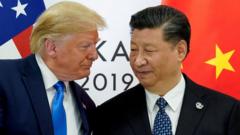Japan's Defense Ministry reported a dangerously close encounter involving a Chinese fighter jet and a Japanese military aircraft, amplifying worries about the escalating military presence in the Pacific.
Japan Raises Alarm Over Close Call with Chinese Fighter Jet

Japan Raises Alarm Over Close Call with Chinese Fighter Jet
Recent maneuvers have intensified concern over regional military tensions.
In a concerning incident last weekend, Japanese defense officials announced that a Chinese fighter jet had flown alarmingly close to a Japanese P-3C surveillance aircraft over international waters in the Pacific Ocean. The near-miss incident, which reportedly took place as the Japanese aircraft was conducting surveillance operations, raises serious apprehensions about China's military assertiveness in the region.
According to the statement from Japan's Defense Ministry, the Chinese J-15 fighter jet came within a mere 150 feet of the Japanese plane on Saturday and made a particularly alarming move on Sunday, cutting in front of it within 3,000 feet. Such maneuvers present a significant risk of collision, prompting Japan to express its grave concerns. Defense Minister Gen Nakatani conveyed Japan's call for preventive measures to avoid such dangerous incidents in the future, stating that mishaps of this nature could lead to catastrophic accidents.
General Yoshihide Yoshida, the chief of Japan's joint staff, voiced concerns about the increasing probability of a collision, particularly as the Chinese aircraft appeared armed with missiles. He cautioned that assessing the intentions behind China's maneuvers proved challenging, but reaffirmed that Japan remains vigilant regarding the expanding reach of China's military activities.
In response to Japan's concerns, Chinese Foreign Ministry spokesman Lin Jian offered a counter-narrative, asserting that the underlying issue stemmed from supposedly provocative actions by Japanese aircraft and calling for Japan to adopt a more objective and rational perspective regarding the military encounters.
This incident is not an isolated case, with past encounters involving Chinese military jets creating tensions in the region. In 2022, a Chinese fighter jet almost collided with a U.S. military aircraft in the South China Sea, reflected the rising challenges in maintaining safety in contested airspace.
With escalating military exercises, including the recent joint drills by China's aircraft carriers in the Pacific, the situation remains delicate as both nations navigate the complexities of their regional military strategies.
According to the statement from Japan's Defense Ministry, the Chinese J-15 fighter jet came within a mere 150 feet of the Japanese plane on Saturday and made a particularly alarming move on Sunday, cutting in front of it within 3,000 feet. Such maneuvers present a significant risk of collision, prompting Japan to express its grave concerns. Defense Minister Gen Nakatani conveyed Japan's call for preventive measures to avoid such dangerous incidents in the future, stating that mishaps of this nature could lead to catastrophic accidents.
General Yoshihide Yoshida, the chief of Japan's joint staff, voiced concerns about the increasing probability of a collision, particularly as the Chinese aircraft appeared armed with missiles. He cautioned that assessing the intentions behind China's maneuvers proved challenging, but reaffirmed that Japan remains vigilant regarding the expanding reach of China's military activities.
In response to Japan's concerns, Chinese Foreign Ministry spokesman Lin Jian offered a counter-narrative, asserting that the underlying issue stemmed from supposedly provocative actions by Japanese aircraft and calling for Japan to adopt a more objective and rational perspective regarding the military encounters.
This incident is not an isolated case, with past encounters involving Chinese military jets creating tensions in the region. In 2022, a Chinese fighter jet almost collided with a U.S. military aircraft in the South China Sea, reflected the rising challenges in maintaining safety in contested airspace.
With escalating military exercises, including the recent joint drills by China's aircraft carriers in the Pacific, the situation remains delicate as both nations navigate the complexities of their regional military strategies.





















